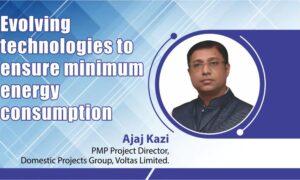Ensuring a minimum bar of quality of products and services for air pollution control and monitoring is very important for the delivery of sustainable solutions
Expressing serious concerns over the pressing concerns of air pollution, Himanshu Agarwal, CEO, Magneto Clean-Tech, discusses various measures to clean the air, and make the climate more people friendly. Further, is expecting few pooling opportunities, and green initiatives from the government, so as to save the environment from the burden of pollution.
Learn from the best but re-invent for India
The Make in India movement has definitely made a positive impact on the HVAC industry. Many local and international companies are now manufacturing, and assembling their air conditioners in India. Companies such as Daikin, Mitsubishi, LG, etc. have set up their production plants locally, and we have openly embraced the movement. We learn from technologies and best practices from the globe but re-invent and make our products in India.
Big investments go digital
While not many HVAC companies have adopted a digital approach, we are continuing to make big investments to go digital. The cloud-based, data-driven approach allows for a personalised and quantified experience to satisfy customer’s needs. For example, we deliver clean air in a measurable manner, using advanced sensing and monitoring to ensure that the inside air is clean no matter the air outside.
Developing ecosystem for incentivisation programs
There need to be incentivisation programs from the government for the HVAC industry, to adopt Make in India and Digital India. Corporates and start-ups in this space need to host competitions and seminars facilitating the discussion of these initiatives. Finally, new incumbents in this space need to be provided resources, industry support and PoCs opportunities. An entire ecosystem needs to be developed around this to make this adoption possible.
Tracking their air quality indoors and outdoors in real-time
The awareness about air pollution and its health impact is spreading among the masses. Air purification and monitoring have become a necessity in buildings, homes, and other facilities. People are interested in tracking their air quality indoors and outdoors in real-time in concern for their health and everyone considers air purification as a need. The long-term solution can only be through public policy by regulating bad construction practices, rampant use of gensets, wood and crop burning, etc. and by promoting carpooling, public transportation, renewable energy, etc. Aside from the government doing its part, it is also the responsibility of the citizens to understand the environmental impact of their actions and act responsibly.
Ensuring a minimum bar of quality
India’s geographic, climatic, and socio-economic conditions, are very different from those of other countries, so it is imperative for us to come up with standards for air quality monitoring and certifications that make sense in the Indian context. Advancements being made by the agencies, such as the central pollution control board and Indian green building council coming out with the national ambient air quality standards and the green rating for integrated habitat assessment; however, there is still a long way to go. Ensuring a minimum bar of quality of products and services for air pollution control and monitoring is very important for the delivery of sustainable solutions to the public.
Lack of HVAC technical expertise at execution level
There is a big knowledge gap on the sustainability front for green building projects with a focus on cutting corners. Organisations such as ISHRAE are attempting to bridge this understanding gap, but most such efforts are yet to have widespread adoption. The only way such hurdles can be overcome is through studying successful cases of green facilities across the globe and adopting suitable best practices for the buildings in India.
Protecting people and people’s assets
There are lots of products that claim to purify the air, but there are only a select few products that are reliable and high performing. Most products are in fact secondary sources of microbial pollution. There are magnetic filterless technologies which work on trap and kill process, that have been used by many corporates, hospitals, hotels, malls, and other residential spaces. These technologies not only protect people but also people’s assets, equipments that have high monetary or sentimental value. Since the air pollution level in India is hazardous, it is important to use solutions that have a high-efficiency without a recurring cost. The conventional filters need to be replaced very frequently and economically unviable, so it is important to look at alternative technologies that are washable and reusable.
Uncertainty still prevails
Air is an extremely complex and volatile substance that changes with season, time of the day, and even the micro-activities in the proximity. Successful implementation of air quality control requires designing for the peak load conditions, which can be very hard to predict. In a lot of cases, despite great system design, the occupants can create pollution themselves through activities including the use of harmful paints and furnishings, introducing aerosols such as room fresheners, and creating particulate pollution through inefficient burning.
Green building certification
A green building certification enforces best practices for construction materials, energy usage, and air conditioning design. It helps minimise the carbon footprint of the building, while creating a safe, comfortable and healthy environment for the building occupants. The certification reinforces the commitment of the building owner and the occupants to be environmentally friendly for the benefit of everyone.
10 billion sq.ft. of green building footprint by 2022
The IGBC is putting in lot of efforts to grow the green building footprint. There are about 4,700 green building projects across India, covering 640 crore sq.ft. Getting to 1000 crore sq. ft. by 2022 will require adding around 100 crore sq.ft. every year. With persistence this is possible, and we’re doing our part to make this happen by providing products that
provide green building credits upon use.
Himanshu Agarwal,
CEO,
Magneto Clean-Tech
Cookie Consent
We use cookies to personalize your experience. By continuing to visit this website you agree to our Terms & Conditions, Privacy Policy and Cookie Policy.














